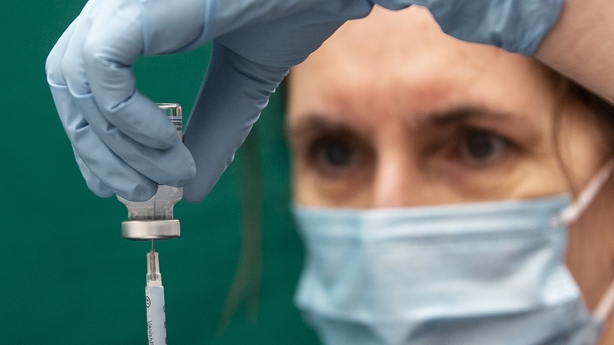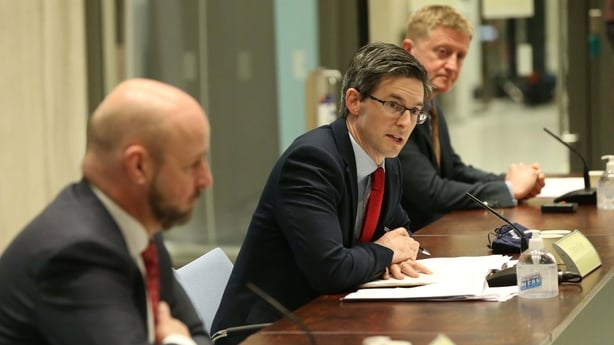As a measure of how the mood music can change rapidly in this public health crisis, last Monday's NPHET media briefing was one of the most upbeat for a long time.
We heard about sustained progress in suppressing transmission of Covid-19 and maybe even signs of accelerated progress.
But by Thursday, the upbeat tempo was gone and NPHET issued warnings about Ireland sailing close to the wind and how a gust in the wrong direction could put us in danger.
It all reflects the turbulent times we are currently in with Covid-19 and why the outlook is uncertain.
Human beings like certainty, so we can plan. But with case numbers still hovering quite high, major vaccine supply problems and around 17 different changes to the vaccination programme, it’s difficult to nail down exactly where we are on the trip and when we will reach calmer waters.
A year into the pandemic, that is causing understandable frustration for people. It’s hard to be sure exactly what happens next.
As the weather improves and the daylight hours get longer, keeping people on message is going to be a challenge.
One of the big questions is what will define the end of the Covid-19 pandemic? At what point will we be able to say in Ireland, that the public health crisis is over and life can return to some relative normality?
But much of what happens next is in our hands.
This week, the Health Information and Quality Authority published its review of the evidence on what can be presumed about the duration of immunity a person has from being infected again, after they have already recovered from Covid-19.
It was believed to be three months. Now that has been extended to six months. It means that people who were infected since late September, are likely immune.
That would be over 190,000 people, given that in mid-September there were around 30,000 cases in Ireland and the number is now over 224,500.
So even without vaccination, there is potentially a large body of people with immunity for a while.
Recently, NPHET said it was aware of four preliminary reports of stillbirths potentially associated with a complication of Covid-19, Covid placentitis - an infection of the placenta.
This week, we got more information about it. In the four cases, the pathologists take the view that Covid placentitis was the significant factor in the stillbirth of these babies.
Experts say this is quite a rare event. Around 10 cases have been reported in the literature outside Ireland. Doctors here are somewhat puzzled as to why Ireland has only really seen it mainly in the last few months.
In fact, we have seen five cases reported in all. The first case was published in the medical literature in January in the journal Placenta.
It involved a 26-year-old woman who attended Cork University Hospital early on in the pandemic last year. The problem arose in the third trimester of pregnancy when she got Covid-19 and there were subsequent reduced fetal movements.
This was a near-miss case and an emergency caesarean section was performed. The surgery was carried out in a specially designated theatre and with staff wearing personal protective equipment.
The doctors involved say they found demonstrable Covid-19 placentitis after the placenta was sent for pathological examination. The good news is that there was a positive outcome to this case with a baby girl.
It does raise questions as to why Ireland has seen five reported cases, and there have been so relatively few reported around the world. Better understanding of this complication is important, given the potential risks for mother and baby.
But for context too, remember that around 50,000 women delivered babies here last year. Around 500 mothers had Covid-19 and most experienced mild to moderate symptoms.

The national vaccination programme continues and over 540,000 doses had been administered to people by last Tuesday. The HSE has expressed frustration over interruptions to the supply of vaccines. The original expectation of 1.7 million doses has fallen to around 1.1 million doses for the first quarter of this year, which is the end of this month.
After that, just under one million doses are expected to arrive in April, 1.25 million in May, and 1.68 million in June. Based on those figures, by June, Ireland will have received over five million doses. As the number of people in the population that can be vaccinated is put at about 3.75 million people, everybody should have received a first dose and many will have got their second dose at this point. That’s the plan anyway.
We have to dig deep now, within ourselves, for the optimism that brighter days, will follow dark times.
The fresh recommendation from the National Immunisation Advisory Committee that the AstraZeneca vaccine can be used for those aged 70 and older may help a little. It’s easier to transport and use.
The big issue however is the interruptions to the supply lines and whether AstraZeneca can be relied upon.
The Irish Medical Organisation has said GPs would be cautious about switching from Pfizer to AstraZeneca for the over 70s, if the supply lines were not secure, especially as they and their patients have become familiar with the Pfizer jab now.
The Taoiseach has sought a meeting with the AstraZeneca chief executive for next week to discuss the supply problems.
News of the European Medicines Agency approval for the Johnson & Johnson vaccine is very welcome. Ireland has ordered 2.2 million doses of this single-dose vaccine. Unfortunately just 600,000 doses will arrive between April and June and most of this batch will not come here until June.
But if the vaccination doses arrive as set out, the only issue will be making sure they are administered efficiently and effectively. The HSE says it already has 9,700 health staff who are trained to give the vaccines. On top of this, it is recruiting 2,000 vaccinators through a private firm.
Quite soon, we should be seeing vaccination on a very large scale, involving GPs, pharmacists, dentists and others and mass vaccination centres. The Government has promised 37 mass vaccination centres and each will have around 800 booths. The centres will vary in size but the plan is that they will deliver between 1,000 and 5,000 vaccines a day. The aim is to have 250,000 vaccinations a week - a million a month in April, May and June. This is the big event and all eyes will be on it.
The indications from Government this week are that after 5 April there may be some small easing of restrictions likely, with construction back, an easing of the 5km limit and some activity allowed outdoors, like golf, tennis and non-contact sports. Then there would be a further period of no change until another review, some time later in May.
The 'triple lock’ set out by NPHET for any slow and gradual easing of restrictions has the following conditions. Cases in the community must be at low levels, so that they can be managed by public health. Hospital and ICU cases need to be reduced.
The most vulnerable must be protected through vaccination. There has been good progress on the first two conditions - issues which the public have some control over through their actions. On the third area, vaccinations, the public has no control.
People regularly ask who is responsible for the vaccination programme. It is the biggest project of its kind undertaken by the State. There are many people and agencies involved. However, as the HSE chief, Paul Reid explained at the Oireachtas Health Committee last week, the HSE is responsible for the delivery of vaccines into people’s arms, the Department of Health/Minister Stephen Donnelly are responsible for dealing with vaccine supply.
We are now seeing about 500-600 cases reported a day. Down from the peak number of 8,242 on 7 January, although a good slice of that was backlog numbers. The true daily peak recorded was about 6,000 cases.
One of the questions put to NPHET at last Thursday’s media briefing was the lack of granular detail about the 500 or 600 cases we hear about each day. Where did they originate? Where is the tracking and tracing back to the source, to be sure where exactly these cases have come from?

Deputy CMO Dr Ronan Glynn said Ireland was still at a level of the disease where it is difficult to track and trace cases. He said people would struggle to find another country linking all of its clusters and reporting on it.
Dr Glynn said it is about being realistic and directing resources to where they are needed at a point in time. The HSE has said that retrospective contact tracing has resumed in some cases but generally it will not resume until the daily case numbers are consistently below 600.
There was an admission during the week, from Paul Reid, that its IT system for public health was "probably not match fit" for a pandemic.
On RTÉ’s Prime Time, public health doctors expressed frustration that a lot of the data they collect on outbreaks can not be fed into the existing system's database, because of its limited and predefined variables.
Some public health specialists explained that when working on complex family, or community outbreaks, they cannot visualise the connections easily, because they simply do not have the software. Sometimes they must make do with pens and Excel spreadsheets. This is the working situation for them over a year now since the start of the pandemic here.
We are still in the third wave of this disease, but things have improved. The Health Protection Surveillance Centre has published an interesting review of the third wave. It found that the wave began on 22 November. That was before the reopening of hospitality in early December, followed by allowing inter-county travel and more relaxation for household visits.
Most Covid-19 cases and deaths have occurred during this third wave. It has accounted for over 67% of cases and over half of all deaths. There have been more cases in women but more deaths in men.
There have been so many ups and downs on this journey with Covid-19, people are dizzy and frazzled.
Sometimes, maybe, we miss how far we have actually come and the real progress we have made.
People have worked hard to get to this point. Being in Lockdown 3 for around 11 weeks has been testing for everyone. And a further three weeks have to pass before the Government review of where we are at is completed, with input from NPHET.

As the weather improves and the daylight hours get longer, keeping people on message is going to be a challenge. Behaviour analysts say there has been some slippage by a minority in terms of sticking to public health guidelines.
If the promise of delivering one million vaccinations per month from April can be achieved, that will bring real hope to people.
It has been a year of great loss – lost lives, freedoms and happiness.
In an atmosphere of mixed emotions - frustration, anxiety and uncertainty, there must be room for hope.
As we learned this week, things can take a bad turn unexpectedly, but the opposite is true also and things can rapidly improve.
We have to dig deep now, within ourselves, for the optimism that brighter days, will follow dark times.







